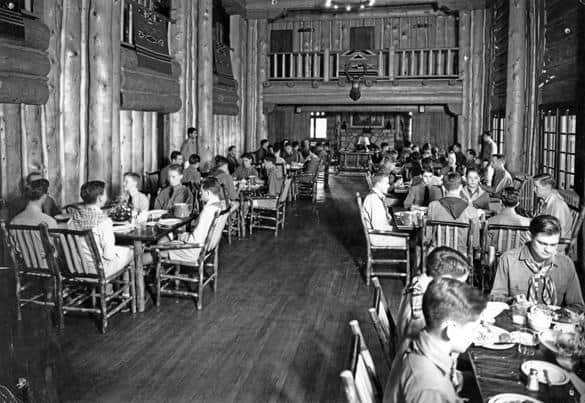 Boys of the Los Alamos Ranch School at dinner in the Dining Hall at Fuller Lodge, ca. 1930s before the final group of graduates left the school in 1943. Courtesy/LAHS
Boys of the Los Alamos Ranch School at dinner in the Dining Hall at Fuller Lodge, ca. 1930s before the final group of graduates left the school in 1943. Courtesy/LAHS
By Sharon Snyder
Los Alamos Historical Society
In the 25 years of the Los Alamos Ranch School’s existence, more than 550 boys came to the Pajarito Plateau as students and/or summer campers. Almost all of them went on to earn college degrees and make contributions to their chosen communities and, in many cases, to the nation.
The last four boys to graduate from the ranch school in late January of 1943 went on to make the school proud, and they epitomize the young men who were our “LARS boys.”
Collier Whittemore Baird Jr., LARS 1940-1943, came from New Jersey. After graduating he joined the U.S. Army 26th Yankee Infantry Division and saw action in northern France, the Ardennes, Rhineland and Central Europe before taking part in the Battle of the Bulge. Baird earned a Bronze Star and a Purple Heart in World War II and returned home to run Baird Rubber and Trading Company in New York City, a business started by his grandfather.
He married and had a son, Collier III, and two daughters. Baird and his wife battled chronic obstructive pulmonary disease, and in their will they left a “significant donation” toward a new Pulmonary Rehabilitation Center at Morristown (NJ) Medical Center. Baird was an ordained elder in the Presbyterian Church and volunteered at Morristown Memorial Hospital. He died in 2006 at the age of 82.
William E. Barr, LARS 1937-1943, was born and raised in Chama. In accordance with tradition, Barr had to choose a nickname upon registering because another boy at the ranch school already went by the name of Bill. No two boys could have the same first name, so he became known as “Bee” for his years at LARS. Following graduation, Barr served in the U.S. Navy, attaining the rank of Lieutenant Jr. Grade.
He returned home from World War II to earn a degree in Mechanical and Chemical Engineering and went on to a 41-year career with Phillips Petroleum Company. The highlight of that career was leading the Ekofisk Lift Project that saved one of the most important oil fields in the North Sea. He retired as Senior Vice President of Engineering. He and his wife were married for 64 years and had four children. Barr loved golf, and he especially loved it on the day he hit a hole-in-one! He was a member of the First Baptist Church of Bartlesville, Sigma Chi fraternity and the National Society of Professional Engineers.
Theodore Spencer Church, LARS 1937-1943, was born in Santa Fe, and grew up at the ranch school. It seems fitting that one of the last four graduates was a grandson of the school’s founder, Ashley Pond Jr. Church was the son of LARS Master Fermor Spencer Church and author and poet Peggy Pond Church. He entered Harvard at mid-year and then transferred to Massachusetts Institute of Technology to enter the U.S. Navy’s V-12 program, where he remained through World War II.
In June of 1946, he was assigned to the USS Marvin H. McIntyre as an ensign. He went on to graduate from MIT with a degree in electrical engineering, and then began his 43-year career with the Los Alamos Scientific Laboratory in the Applied Physics Department at Sandia Base, eventually becoming a Sandia National Laboratories employee and retiring in 1990. Church became an involved member of the Religious Society of Friends, holding the position of Clerk of the Friends Inter-Mountain Yearly Meeting, and as a member of the Quakers’ Religious Society of Friends, he served on the American Friends Service Committee and the Friends World Committee for Consultation at the Quaker United Nations Office. He and his wife had two children. Church died in Albuquerque in 2011, 10 days short of 87.
Stirling Auchincloss Colgate, LARS 1940-1943, was born in New York City. He entered Cornell University at mid-year and eventually earned a degree in electrical engineering, though his studies were interrupted by enlistment in the Merchant Marines during World War II. Discharged in 1946, he continued his education, including his PhD in nuclear physics from Cornell in 1951. He then became a postdoctoral fellow at the University of California, Berkeley.
From 1952–1965, Colgate was involved in diagnostic testing of nuclear weapons as Lawrence Livermore National Laboratory. In 1965, he became president of the New Mexico Institute of Mining and Technology, moving on in 1976 to Los Alamos National Laboratory to work in the Theoretical Division. In 1985, he was elected to the National Academy of Science and received the Rossi prize for work in astrophyics in 1990. Colgate and his wife had two children. He died in Los Alamos in 2013 at the age of 88.
Upon the announcement of Stirling Colgate’s death, LANL Director Charlie McMillan commented, “His contributions to physics and national security science, including some very recent work, are broad, deep, and exceptionally creative.”

